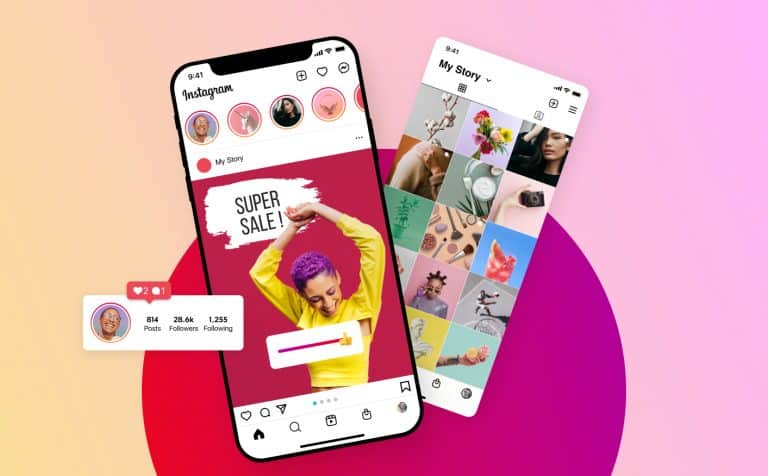
How Much Does It Cost to Advertise on YouTube?
1.9 billion.
That’s how many individually logged-in users there were on YouTube this year.
And considering you can watch YouTube, without logging into the platform, chances are there are even more people than that watching content. While the number is impressive (to say the least) when you’re considering allocating some of your marketing budget into YouTube Advertising, it’s natural to wonder a few things: Are YouTube Ads worth the investment? What’s the ROI? What’s the average cost of YouTube advertising, anyway?
These are good questions, for all of which we have good answers.
Why invest in YouTube ads
First, let’s just take a look at video marketing in general. Video content is the new goldmine that just keeps on giving. But don’t simply take our word for it, look at the data. According to WordStream, these are the most recent statistics around video marketing:
- “Marketers who use video grow revenue 49% faster than non-video users.”
- “Video drives a 157% increase in organic traffic from SERPs.”
- “Viewers retain 95% of a message when they watch it in a video compared to 10% when reading it in the text.”
And that’s just a broad look at video advertising, but when you focus on YouTube, it’s a whole new level. Leave it to the experts at YouTube to know exactly what, where and why people are watching videos. Here a couple example of companies who boosted their business with Youtube:
For instance, Tuft & Needle is a mattress startup that had only $6,000 to invest in their business.
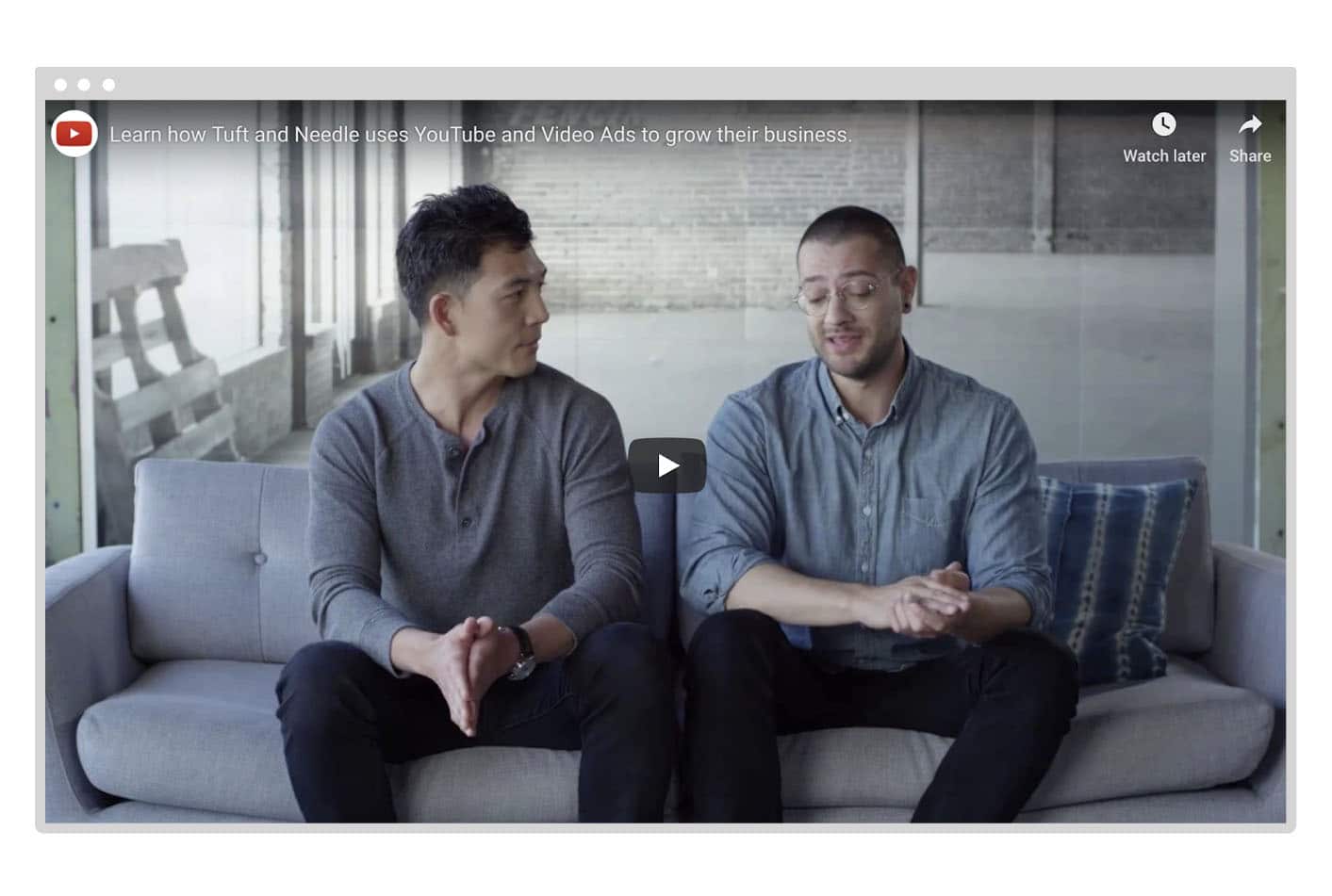 They invested some of that money into running video ads on YouTube. The result?
They invested some of that money into running video ads on YouTube. The result?
They earned $100 million in sales and now one million people will be sleeping on their mattresses. They attribute this growth to YouTube and plan to continue on this advertising channel to hit new business goals.
Another example is from a short case study by Eric Siu, CEO of Single Grain. Before he started his company, he worked for Treehouse, a company that teaches others how to code. Their digital marketing plan at the time wasn’t doing anything to help them grow their business and they were only 5 months away from running out of money.
Eric looked for any channel that was giving them some sort of traction, and luckily for him, he chose YouTube as that channel. He decided that Treehouse needed to pause all other ads and “double down” on YouTube.As a result, their signups skyrocketed and they were able to keep their cost-per-click (CPC) down to a few cents each. YouTube became their number one customer acquisition channel and helped bring Treehouse back from the brink of despair.
These are very different types of companies, and yet their ROI on YouTube was so impactful that it helped them to scale their business above and beyond their expectations. Imagine what it could do for you.
Pro tip: Wondering how much money you can make on YouTube? Use our YouTube Money Calculator to hone in on your potential. Just show us some of your numbers and we’ll give you estimated daily, monthly, and yearly earnings.
The cost of YouTube Advertising: Factors that impact ad costs
So the question is simple: What’s the cost of advertising on YouTube?
Thankfully, there is a general number to answer that.
According to Blue Corona, YouTube charges you per-video-view and averages cost for $0.10 – $0.30 per view and only charges you for the people who choose to watch your ad.
So let’s say you manage to get your costs per view down to $0.12 and over the course of your ad campaign, you get 4,500 views. This ad will ultimately cost you $540. This is just a rough example, so keep in mind that there are a lot of factors that will end up impacting your bottom line.
It takes a lot of time and dedication to understanding every little thing there is to know about Google Ads (previously Adwords) and YouTube Ads, but you don’t need to know everything to get started. To get started, be sure to read our YouTube Advertising Guide to guide you through the basics and help you set up your YouTube ads.
In this article, we’re going to cover the average cost of YouTube ads and the factors that impact that cost.
Let’s get started.
Cost factor number 1: Bidding strategy
Like we’ve seen with most video advertising platforms, when you’re running ads on YouTube, you will only pay as much as you want to pay.
This amount is called your bid amount, and you can rest assured that Google will never go over your set bid amount.
There are two ways that you set your bid amount:
- Daily bid amount (aka your daily budget)
- Campaign total (how much you are willing to spend on your campaign all in all)
You also have options when it comes to your bidding strategy.
Your bidding strategy is a bit different from your bid amount. It’s how you want Google to spend your budget (bid amount). There are two types of strategies:
- Reserved
- Auction
For beginners, we advise staying away from reserved bidding and sticking to the auction bid because it offers you so many more options.
However, even when it comes to the auction bid, things can still get a little tricky. According to Google, there multiple auction strategies for YouTube Ads:
- Maximum cost-per-view (CPV). The bid amount that you set is the most you want to pay per view.
- Maximum CPM. The bid amount set is the most you want to pay for every thousand times your ad is shown (cost-per-thousand impressions).
- Target CPM. The bid amount is the average cost you’re willing to pay for every thousand times your ad is shown (average cost-per-thousand impressions).
- Viewable CPM. The bid amount set is the most you want to pay for every thousand viewable impressions of your ad. According to Google, when you choose this then an ad is considered “‘viewable’ when at least 50% of the ad shows on screen for two seconds or longer.”
- Target cost-per-action. With this one, Google Ads will by default set bids to give you as many conversions as possible at the target cost-per-action (CPA) you set via the bid amount. Google states that “you’ll be billed at a cost-per-thousand impressions (CPM) rate because Target CPA automatically finds an optimal CPM bid for your ad each time it appears.”
- Maximize Conversions. This strategy will set your bids to automatically help you maximize conversions within your budget.
| Side note: You might notice cost-per-click (CPC) is not listed. We didn’t include it here because Google doesn’t list this as one of the bidding strategies for YouTube video ads. But, clicks are counted toward your costs when you choose a cost-per-action (CPA) as your strategy so in a roundabout way paying for clicks is there, but it’s not called CPC. |
Keep in mind that depending on the Campaign Goal you chose when you set up your ad, your bidding strategy may be set by default.
For example, if you choose a Video ad campaign (ad type) + Brand awareness and reach (the goal) + Skippable in-stream ads then your bid strategy is set to Target CPM by default and you can’t alter it.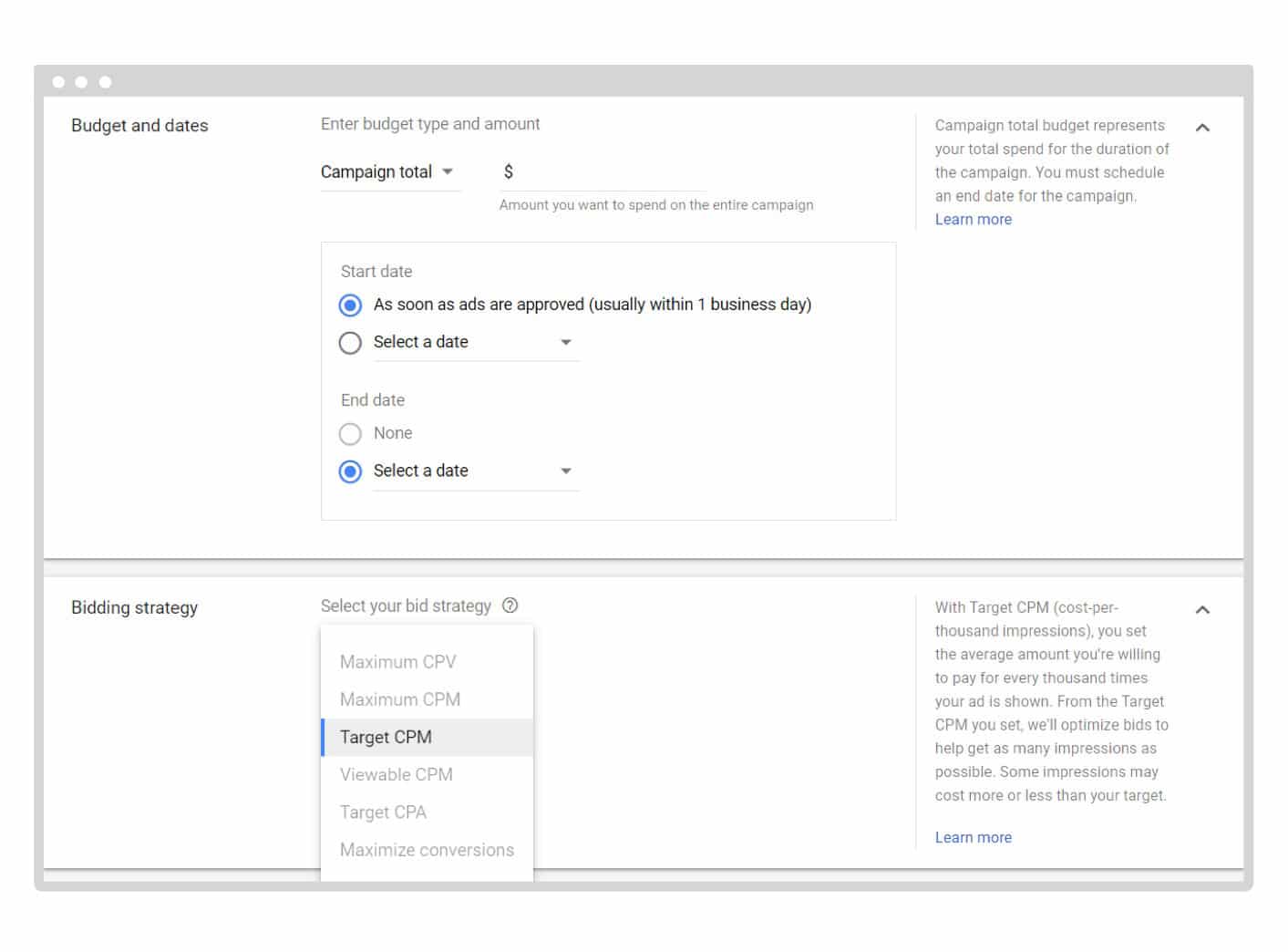
It’s important to test your ad goals and campaign subtypes to see how they impact your ad spend and ROI. As you test and get more familiar with the platform, you’ll be able to make better ad choices with bidding strategies that are more cost effective for your business.
You can learn more about measuring and refining your ad campaigns on YouTube Advertising here.
Cost factor number 2: Competition
When we say “competition,” we are actually talking about several factors. So before we dive in, let’s try to paint a visual picture of the YouTube advertising world:
Imagine Google/YouTube ads as a large auction room.
In the room, Google is auctioning off ad placements and the audience (you and your competitors) are in the same room bidding on those placements in hopes of winning them for your business.
Now, just like in a real auction room where other people can drive the cost of the bid up, your competitors can drive the costs of placements up by bidding different amounts on the same keywords, demographics, and audiences, etc. The more competitors that bid on the same target audience, keyword, the higher the cost will be. But the good news is that Google doesn’t always award the highest bidder. Your ad relevance (quality score) has a big impact and who wins (more on that in a second.)
Ultimately, while this bidding process does affect costs, there’s not much you can do to change this. But, the good news is that you are able to lower your costs by optimizing your ads by better targeting and finding keywords, topics, placements, and demographics that better suit your audience and keep them relevant.
The more relevant the ad is and the better your audience targeting is, the bigger the chance is for you to beat your competitors at a lower rate and find areas of low competition that don’t cost as much. To learn more about all your targeting options on YouTube, be sure to check out our YouTube Advertising guide.
Cost factor number 3: Ad relevance (and video quality)
Your bid strategy, your ad format you targeting all impact your quality score. You overall ad relevance requires that you optimize each area of your ad and test them to find what’s working for you.
But one other very, very important factor is the quality of your ad creative. When you’re creating video ads, you have to make sure that your footage is top shelf, HD videos that are pixel-perfect no matter the screen size.
A good way to avoid a low quality score is by using a tool like the Promo Editor, where you can create HD, highly engaging and impactful videos. It also can save you a lot of money in the long run. No need to pay for a bunch of HD clips or editing software because you have everything you need in this to create YoutTube ads in this powerful DIY video creation tool. This is especially useful when you’re testing ads on YouTube and need multiple variations to find out what’s working.
We recommend that you bookmark this Google list for some of the most effective ways to optimize your YouTube ads (and 7 other tips that are worth reading).
Keep in mind that seasonal factors can also have an impact on your relevance score and raise the cost as other brands flood marketing channel for the holidays. We suggest hanging your message to embrace the holidays to help you keep your ad relevance score up to par and help keep costs low, even for the holidays.
Cost factor number 4: Ad formats
There are quite a few different ad formats on YouTube. Each format serves a different purpose so these are the ads you should probably consider for your campaigns.
TrueView ads (In-stream ads)
TrueView ads are video ads that YouTube rolled out not too long ago. It’s actually become a pretty big success and favorite among advertisers because you only pay for, well, true views of your content.
According to Google, TrueView ads make sure you only pay “when a viewer watches 30 seconds of your video (or the duration if it’s shorter than 30 seconds) or engages in other video interactions, such as clicks on the call-to-action overlays (CTAs), cards, companion banners, or on the video thumbnail for video discovery ads.”
Basically, it works because you’re only paying for video views from people who are genuinely interacting with your content. These type of ads are usually of a longer length (30 seconds or more) and act more like traditional commercials than a social ad.
Google lists 2 main TrueView ads formats:
- In-stream ads. These are very popular and can be mobile ads and/or desktop. In fact, when you’re on YouTube, you’re interacting with these type of ads all the time. This format of ads on YouTube usually shows before a video plays. After 5 seconds, you have the choice to skip the video which you don’t pay for it they do. These ads also let you add CTAs to them to help drive conversions and action.
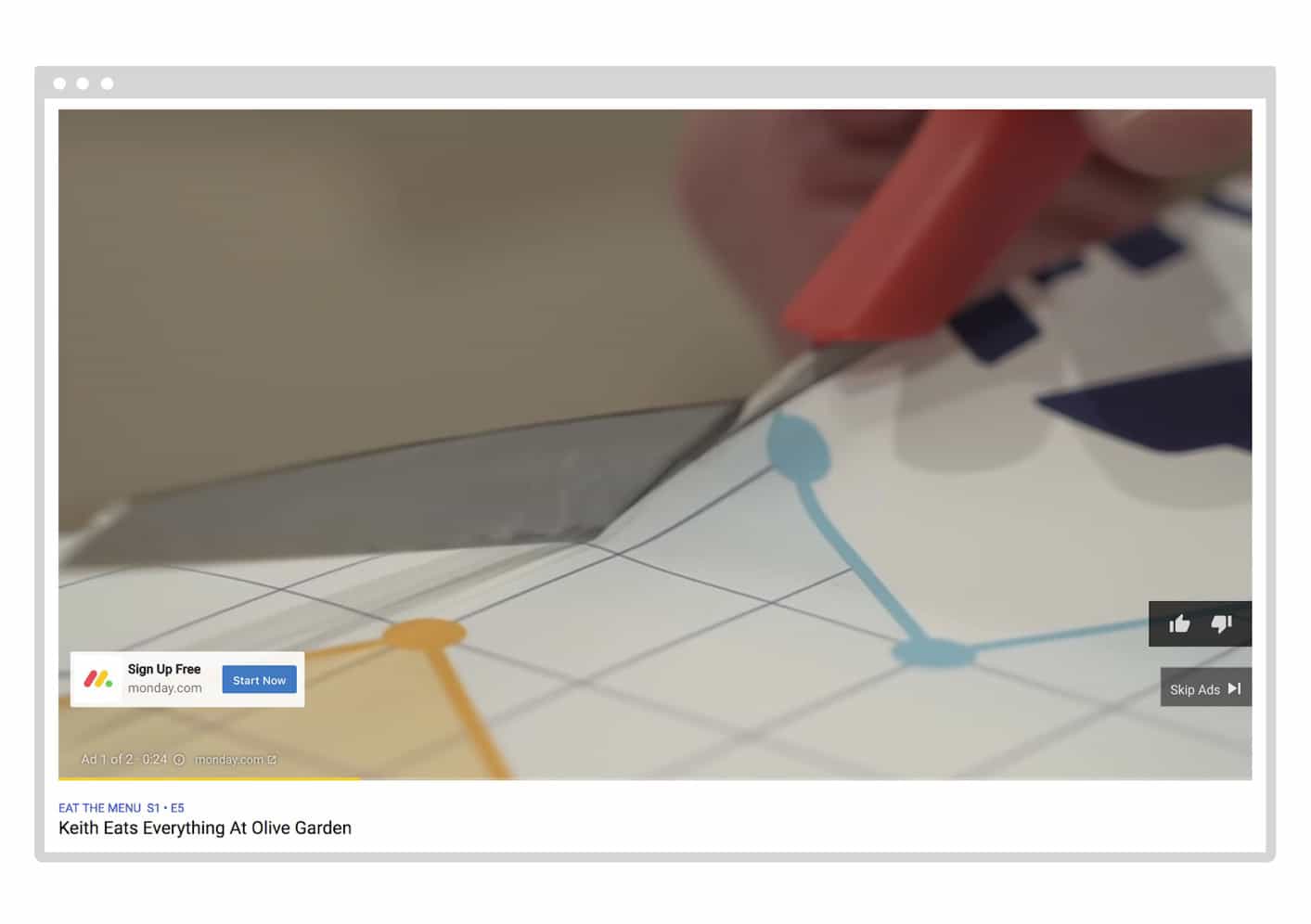 Example of an in-stream ad with CTA overlay within an ad
Example of an in-stream ad with CTA overlay within an ad
You can set in-stream ads ad skippable or non-skippable in your subtasks when creating your ad. Pre-roll ads are also wrapped into the new TrueView in-stream ad type. Learn more about this ad format here.
- Video discovery ads. These ads appear on the homepage, search results, and show up in the related video section. These are slightly different from direct in-stream ads since they don’t play in the content of another video. These ads are served to an interested audience based on your targeting and help promote a good click-through-rate (CTR). Learn more about this ad format here.
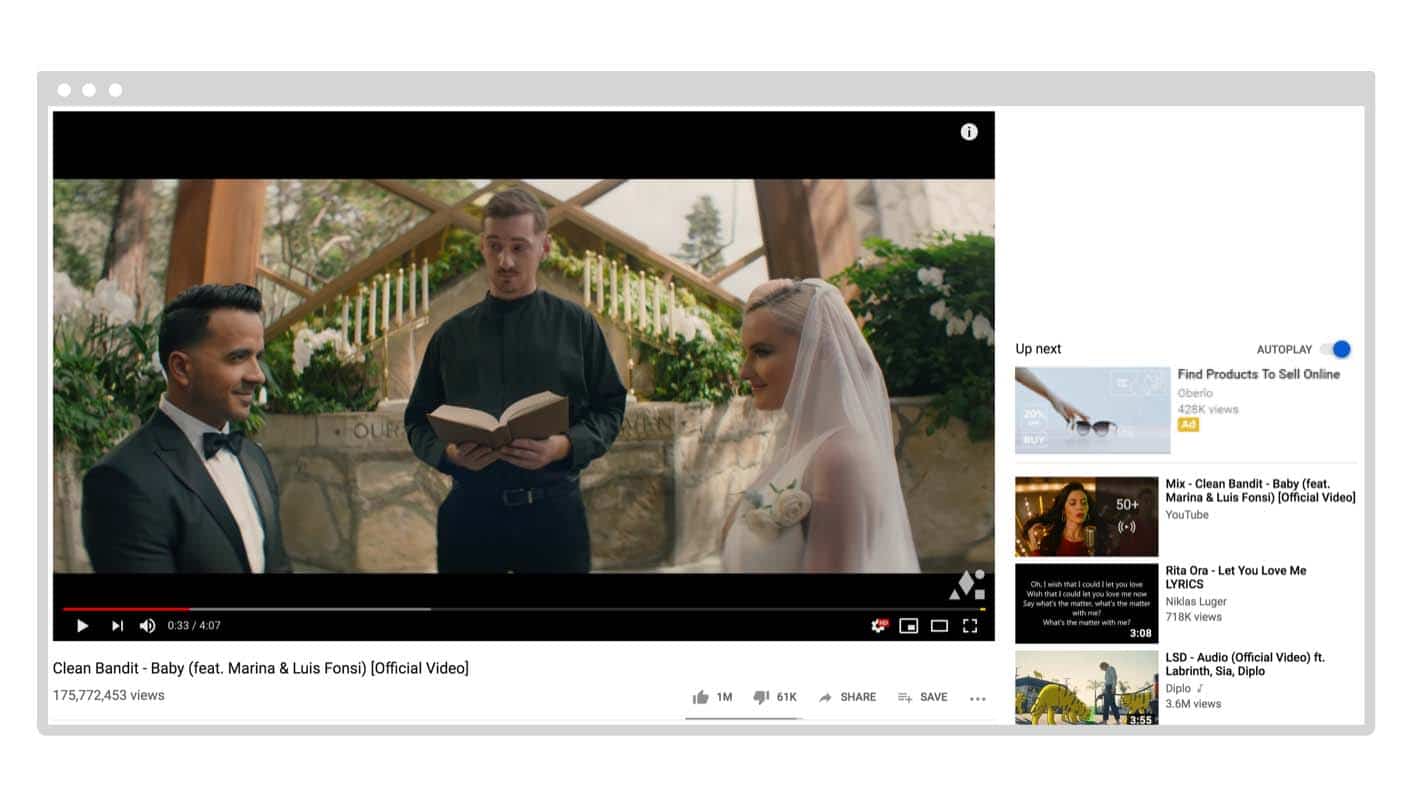 Example of a Discovery ad (top left)
Example of a Discovery ad (top left)
What the difference between these two and how are you charged?
Google says, “With TrueView in-stream ads, you pay when a viewer watches 30 seconds of your video (or the duration if it’s shorter than 30 seconds) or interacts with your video, whichever comes first. With TrueView video discovery ads, you pay when someone clicks on your ad to watch the video. This means that you will only pay when someone chooses to engage with your ad.”
Bumper Ads
Bumper ads are non-skippable videos that are limited to only 6 seconds and are best used for brand reach video campaigns. According to Google, these type of ads are more like add-ons that you can run alongside your TrueView campaigns, but when using them “9 out of 10 bumper ads resulted in a significant lift in ad recall.”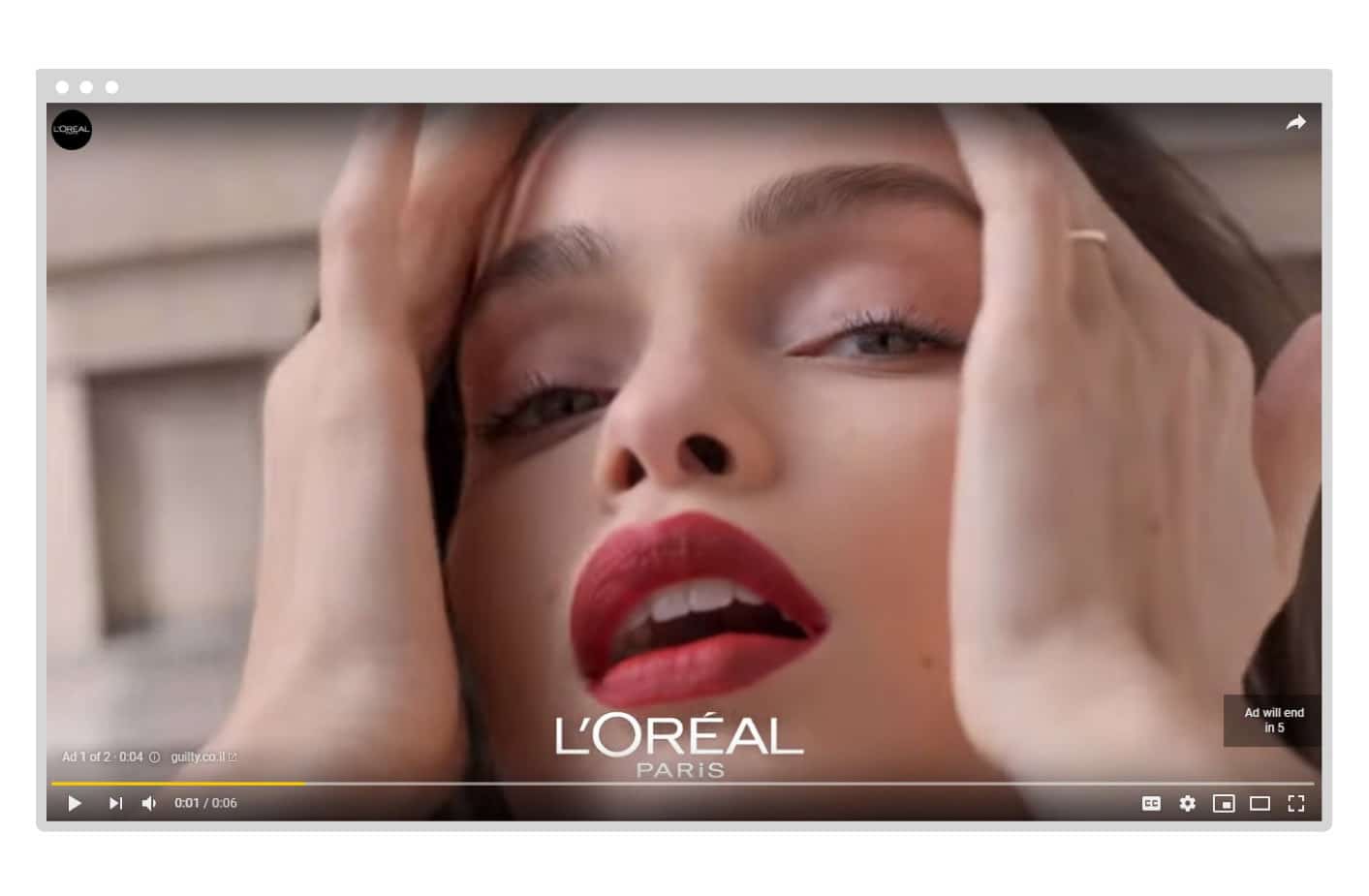 Bumper ad example
Bumper ad example
They can include CTAs just like TrueView ads, but the biggest difference here is that they’re short and they can’t be skipped (though YouTube has limited unskippable content). Since bumper ads are shorter in nature, they tend to cost less. But again, it depends on your targeting.
| Pro tip: Use bumper ads to drive consumer awareness, but then follow up a TrueView campaign to cultivate further interest. You can also get creative and use bumper ads as part of a remarketing campaign. |
This article by Instapage is a very comprehensive overview of bumper ads, and we highly recommend you read and bookmark it.
Other ad types that aren’t video-specific
YouTube advertising also has ad options that don’t include video. This is great if you’re still getting into video marketing but you want to start testing YouTube ads for traction.
Here are a few ad formats you can use that aren’t video
Overlay Ads. These are desktop only ads that show in the lower 20% of a video within your target audience. However, this specific name type ad is reserved for sponsorship campaigns only. Thankfully, there’s a workaround. You can set up an Image Ad in Google Ads to appear as an overlay just like this.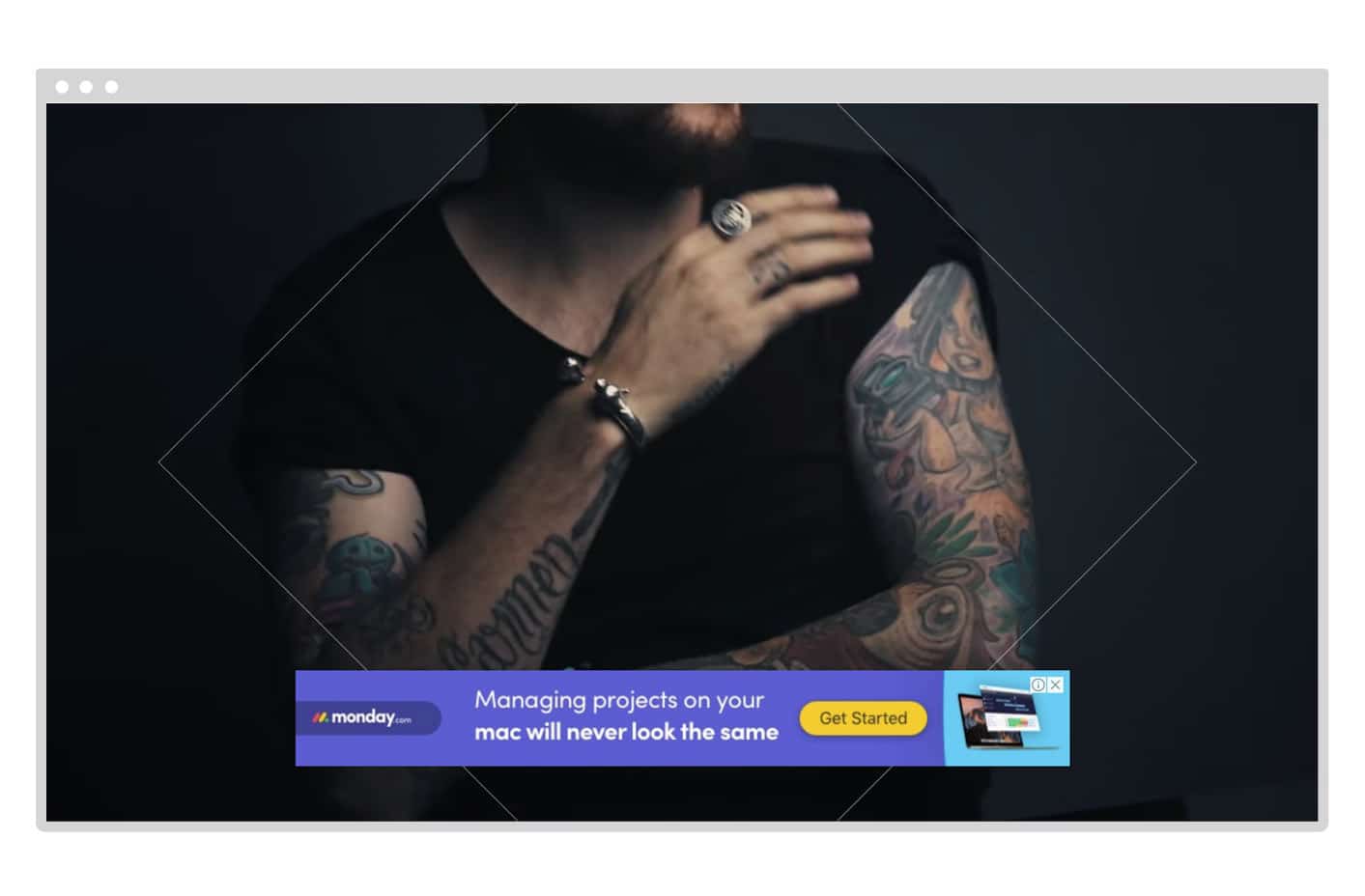 Overlay ad example
Overlay ad example
Display Ads. Another desktop only ad format, the Display ads show up in the top right column of your desktop screen. Although, if your viewing window is larger, it could push the ad under the fold of the screen. 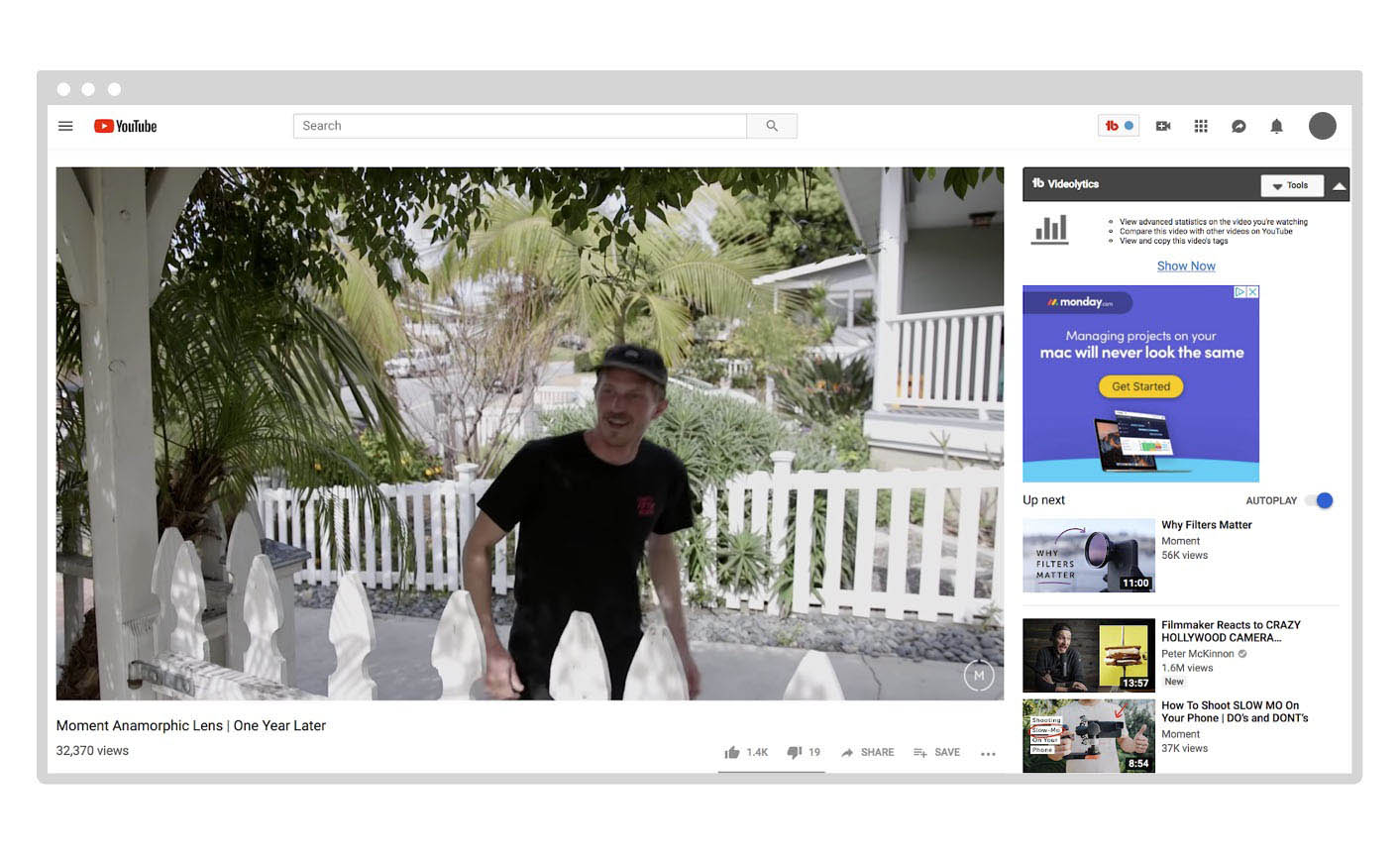 Display ad example
Display ad example
Cards and Sponsored Cards. You can buy ad placements on videos and display an ad card as a sort of overlay that a related in one way or another to the video. Viewers have the option to either click-through the ad or click to close it and get it out of their way.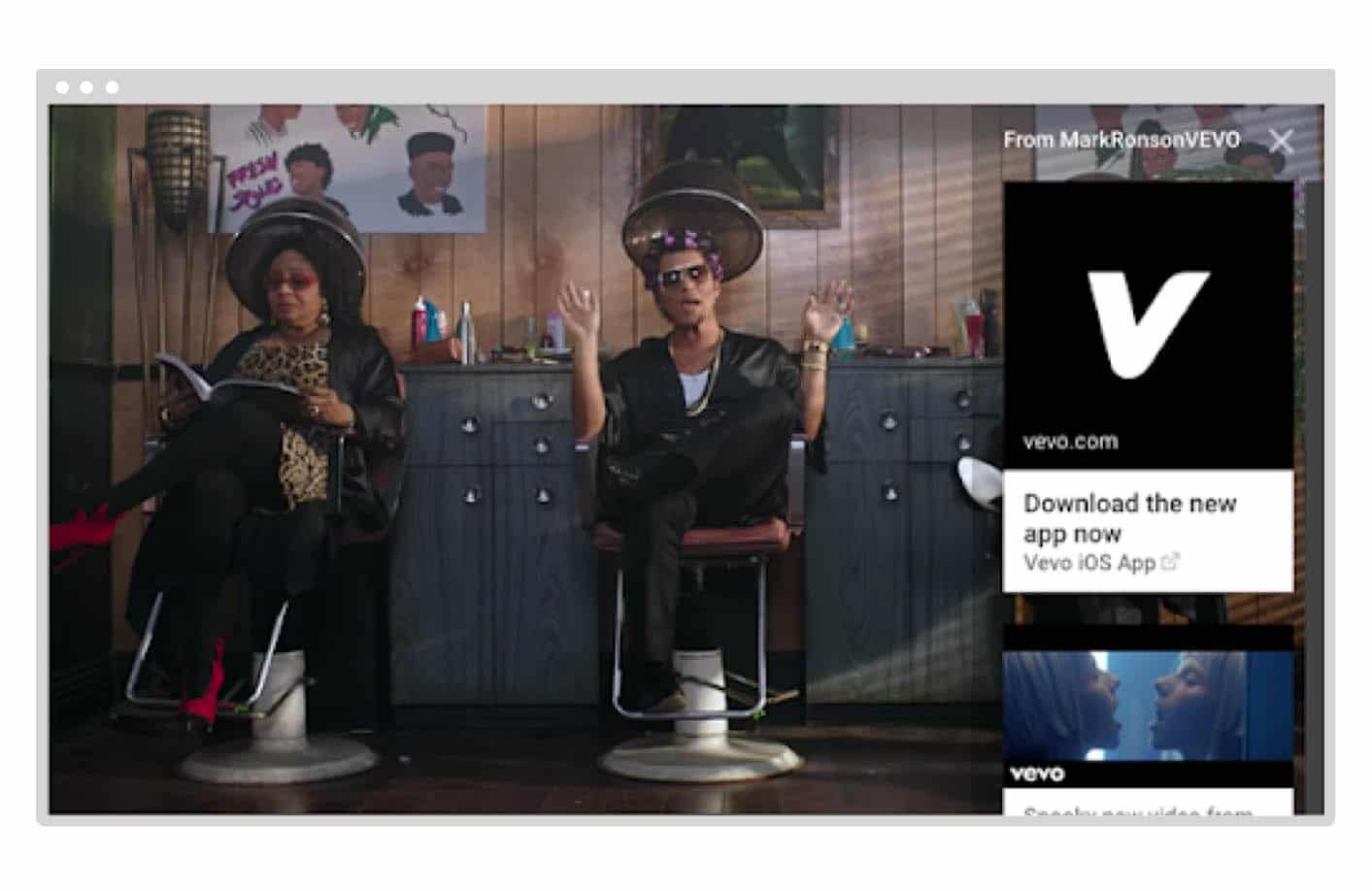 Sponsored card example
Sponsored card example
These are the main ad formats and each one will impact your costs differently. From what we’ve seen, one ad type doesn’t necessarily rank more expensive than others. This usually stems from the bidding strategy and the quality of your ad and your format contributes to the overall quality and helpfulness the ads serve to YouTube users.
The only real way to find out which one costs less is to test variations of your ads and measure their success against each other.
Mistakes that adversely affect YouTube Ads costs
There are 3 common mistakes that we want to make sure you avoid:
1. Not narrowing down your targeting.
If you’re targeting is too broad you might as well throw your money away. Before you start setting up your ads, you should have a good handle on your target audience. You should know everything there is to know about them, including what channels they watch on YouTube, how old they are, where they live and what they do.
The better your targeting is, the more you’re going to get out of your budget and the easier it will be to scale.
2. Not testing enough.
Every business is unique so to find what’s working, it’s important to test your ads in various combinations. If you give up only after running a few ads you could be losing out on an important acquisition channel. What’s more, if you stick to certain without testing any variations, you could be paying more than you have to. Both of which are things you want to avoid.
3. Not creating high-quality visuals.
YouTube is all about videos so quality video content is very VERY important. It’s not always easy to find or create HD video that captures the eye but it’s vital to invest in it. Our Promo editor comes packed full of royalty-free, HD clips and high-quality audio so that you don’t have to worry and wonder if your video is sharp enough. Editing is fast and easy, and you can quickly create as many as you need them so you can keep testing the content of the ads itself too.
4. Ignoring your analytics and metrics.
Are your ads working? You can only find the answer if know what metrics to track in YouTube analytics.
Your cost-per-action (CPA), return on investment (ROI), and your return on ad spend (ROAS) are just some of the metrics you should be tracking and measuring to help you determine if your ads are working. Our video marketing metrics guide will help you learn more about what other metrics worth tracking, but this article on StrikeSocial is a great in-depth dive in ROI and ROAS for YouTube specifically.
Discovering low-cost YouTube ads: Test and refine with video in mind
Perhaps the biggest takeaways from the article are :
- Test, refine, then test and refine some more. There’s not an exact science that everyone can follow for the lowest, best converting YouTube Ads. If only it were that easy, right? To find ads that are low cost, testing over time is vital so don’t give up after a couple of test runs. Test formats, targeting, goals, subtasks, videos, and placements to help increase your ad quality and lower your costs.
- High-quality videos are a must. You need the ability to quickly create engaging videos that will convey your message and meet YouTube’s standards.
With an average cost of $0.10 – $0.30 per view or click in your ad auctions, YouTube is a great option whether you’re on a shoestring budget or not. Learning new ad platforms can feel intense and intimidating, but with enough time and testing, you’ll be cranking out creative YouTube ads that blast your competitors out of the water.
[banner id=11525]


